
While vegans follow a plant-based diet and vegetarians follow a meatless diet that adds dairy and egg products to a vegan diet, an alpha-gal diet is slightly different from both. Although alpha gals cannot eat mammalian meat, like beef and pork, several sources of animal protein are alpha-gal friendly.
The information provided on this site is based on my personal experience living with alpha-gal syndrome. I consistently cite and link to expert sources, but nothing published on this site should be perceived as medical advice.
Alpha-gal sensitivities vary by person. You should understand your dietary restrictions, making any adjustments needed, and directing any questions to your physician.
If a surprise food allergy suddenly forces you to stop eating American staples like ground beef, bacon, pork chops, and steak, it’s easy to become protein deficient if you’re not careful. When I was diagnosed with alpha-gal syndrome, I was told to stop consuming mammalian meats and dairy. And so I did, without any regard to how much protein I should be consuming as a middle-aged woman. Unfortunately, my protein levels quickly dropped, I was exhausted, and my hair was falling out by the handfuls.
Sage Advice: The average American needs 0.36 grams of protein per pound of body weight, with athletes and people over the age of 40 requiring even more protein per day. Use the table below for a ballpark figure of your daily protein intake, or use this nifty protein calculator to get a more precise recommendation.
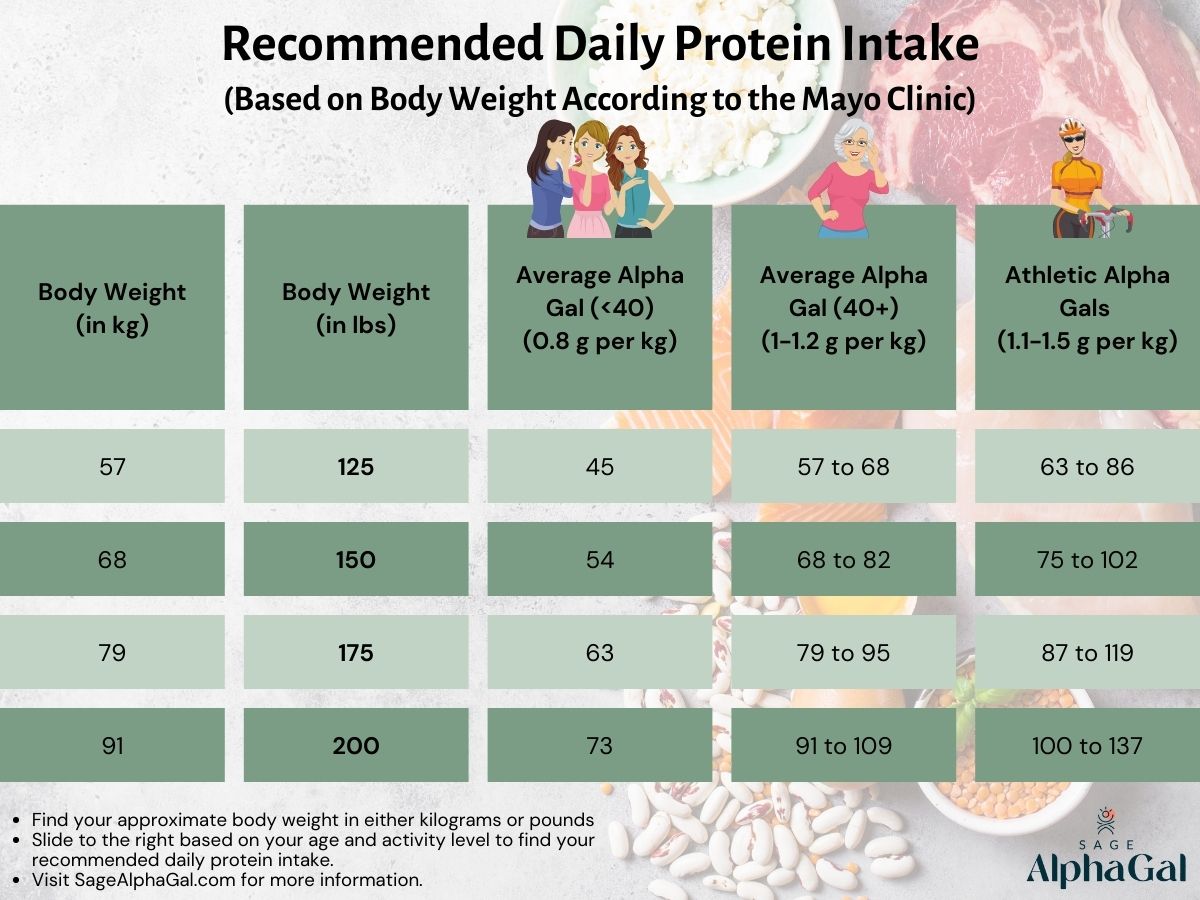
To help offset the costs of running SageAlphaGal.com, you’ll find affiliate links lightly sprinkled throughout the site. If you choose to make a purchase via one of these links, there’s no additional cost to you, but I’ll earn a teeny tiny commission. You can read all of the legal blah blah blah (as my little niece says) on the full disclosure page.
In This Article

What is Alpha-Gal?
Officially known as galactose-α-1,3-galactose, alpha-gal is a sugar molecule found in most mammals. People with alpha-gal syndrome develop an allergy to alpha-gal after being bit by a tick. In the United States, alpha-gal syndrome is most commonly caused by a bite from the lone star tick, easily identified by a white dot on its back. People with alpha-gal cannot eat meat from mammals like cows, pigs, and sheep. Additionally, some alpha gals cannot tolerate dairy products.
Sage Advice: Alpha-gal syndrome is also known as alpha-gal allergy, red meat allergy, or tick bite meat allergy.
Want Alpha-Gal Safe Recipes and More?
Sign up for the weekly newsletter!
Thank You for Subscribing!

What Foods Can You Eat If You Have Alpha-Gal?
While many alpha gals can tolerate dairy, some cannot. If you are one of the lucky alpha gals that can still enjoy traditional milk, cheese, and yogurt products, then you can summarize your alpha-gal diet as vegetarian + poultry + fish. However, I always recommend choosing vegetarian cheeses to reduce the risk of reaction from animal enzymes in some varieties.
If you cannot tolerate dairy products, then you can summarize your alpha-gal diet as vegan + eggs + poultry + fish.
Related Article: Best Milk Alternative for Alpha-Gal Syndrome
Complete vs Incomplete Proteins
Amino acids are the building blocks of proteins, with 20 types of amino acids working together to construct a protein. The human body makes 11 types of amino acids on its own, but we must obtain the remaining nine amino acids – known as essential amino acids – from food. There are two types of protein: A complete protein includes all nine amino acids derived from food, while an incomplete protein is short a few.
Nuts, seeds, and legumes are all incomplete proteins. So when you eat a handful of almonds, a spoonful of sunflower seed butter, or a bowl of rice and beans, you’re not getting all of the essential amino acids your body needs. But when you eat a bowl of Greek yogurt, a fluffy omelet, or a tuna sandwich, you are fueling your body with good sources of complete proteins.
While there are some good complete protein sources for vegans and vegetarians, people living with alpha-gal syndrome have even more options.
Related Article: Embracing a Meatless Diet: Best Vegetarian Protein Sources

Animal-Based Protein Sources for Alpha Gals
Alpha gals cannot consume meat from mammals, but that doesn’t mean they have to stay away from all kinds of meat. In addition to a wide range of proteins from plant sources, poultry and fish are safe animal sources of protein for alpha gals. People living with alpha-gal syndrome can also safely eat eggs, and many alpha gals can safely consume traditional dairy products — those made from cow’s, goat’s, and sheep’s milk.
Alpha-Gal-Friendly Poultry
Alpha-gal friendly poultry options range from basic barnyard birds to wild game birds to exotic birds.
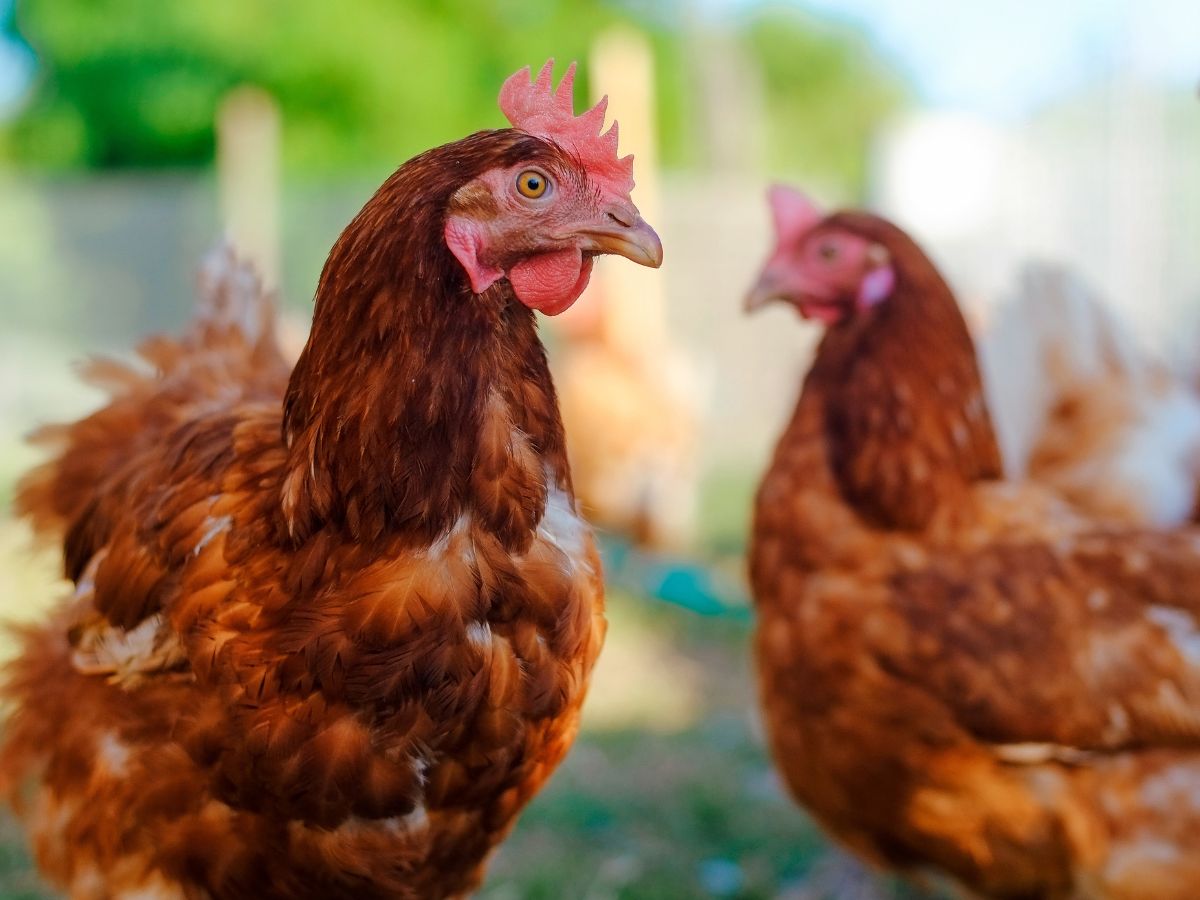
Chicken
Although pork is the most consumed meat globally, chicken is the most popular meat in the US, with the average American eating about 100 pounds per year. That’s a lot of drumsticks and nuggets! Because alpha gals cannot consume red meat, chicken is one of the best animal-based foods for complete protein. But note that some chicken cuts contain more protein than others, with the breast packing the most. One cup of cooked, skinless chicken breast meat contains 43 grams of protein, while the same amount of chicken thigh meat (with the skin) has 34 grams.
If you eat even half as much chicken as the average American, you likely already have a long list of favorite chicken recipes, but here are a few more. Roast a whole chicken for a week’s worth of alpha-gal friendly meat, make a batch of barbeque chicken thighs, or whip up this honey garlic chicken dish for a quick weeknight meal. And skip any potential reaction from frying in lard or beef tallow with this Air Fryer panko chicken recipe.
Sage Advice: If you roast a whole chicken, save the carcass to make nourishing alpha-gal friendly bone broth to sip on its own or add to your other favorite dishes.

Turkey
You don’t have to limit yourself to Thanksgiving when it comes to enjoying the nutritional benefits of this bird. Incorporating turkey into your diet is a great way to get protein as an alpha gal. One cup of cooked turkey meat provides 41 grams of protein, which goes a long way in meeting your recommended daily protein intake. It is also rich in minerals and B vitamins, making it a healthy choice for alpha gals.
Turn holiday leftovers into turkey curry served over mashed potatoes, or make turkey noodle soup instead of the standard chicken variety. Or make these breaded turkey cutlets as an alpha-gal friendly alternative to traditional German schnitzel (made with pork).

Duck
Although richer in color than chicken or turkey, duck is poultry and not red meat. While you may be familiar with classic French dishes featuring duck, like canard à l’orange (duck in orange sauce) and cassoulet (a meat and bean dish), you might not know that duck meat makes delicious alpha-gal friendly bacon and prosciutto.
Smoke or roast a whole duck, or make these soy-braised duck legs in an Instant Pot.

Emu and Ostrich
These large, flightless birds offer alpha-gal friendly meat that most closely resembles beef. However, both pack a bigger protein punch than beef or bison in half the calories. Additionally, emu and ostrich meat are low in cholesterol and high in iron, protein, and several B vitamins. Want to give emu or ostrich meat a try? Amaroo Hills is a family farm owned by an alpha gal.

Quail and Pheasant
In addition to basic barnyard birds – like chickens and turkeys – and exotic birds – like emu and ostrich – wild birds are alpha-gal friendly favorites with hunters. An estimated one million people hunt quail each fall during quail season, especially in top quail hunting states like Idaho, Oklahoma, Iowa, and Kentucky. Pheasant season is typically after that, running from mid-November to the end of January, with South Dakota as a top destination for pheasant hunters.
Related Article: Alpha Gal Food List: Allergy-Friendly Options for Alpha Gals
Fish, Shellfish, and Seafood Safe for Alpha Gals
Alpha gals and pescetarians can enjoy protein from fish, shellfish, and other seafood. Including these animal products in your alpha-gal diet adds variety that will keep you excited for your meals all week long.
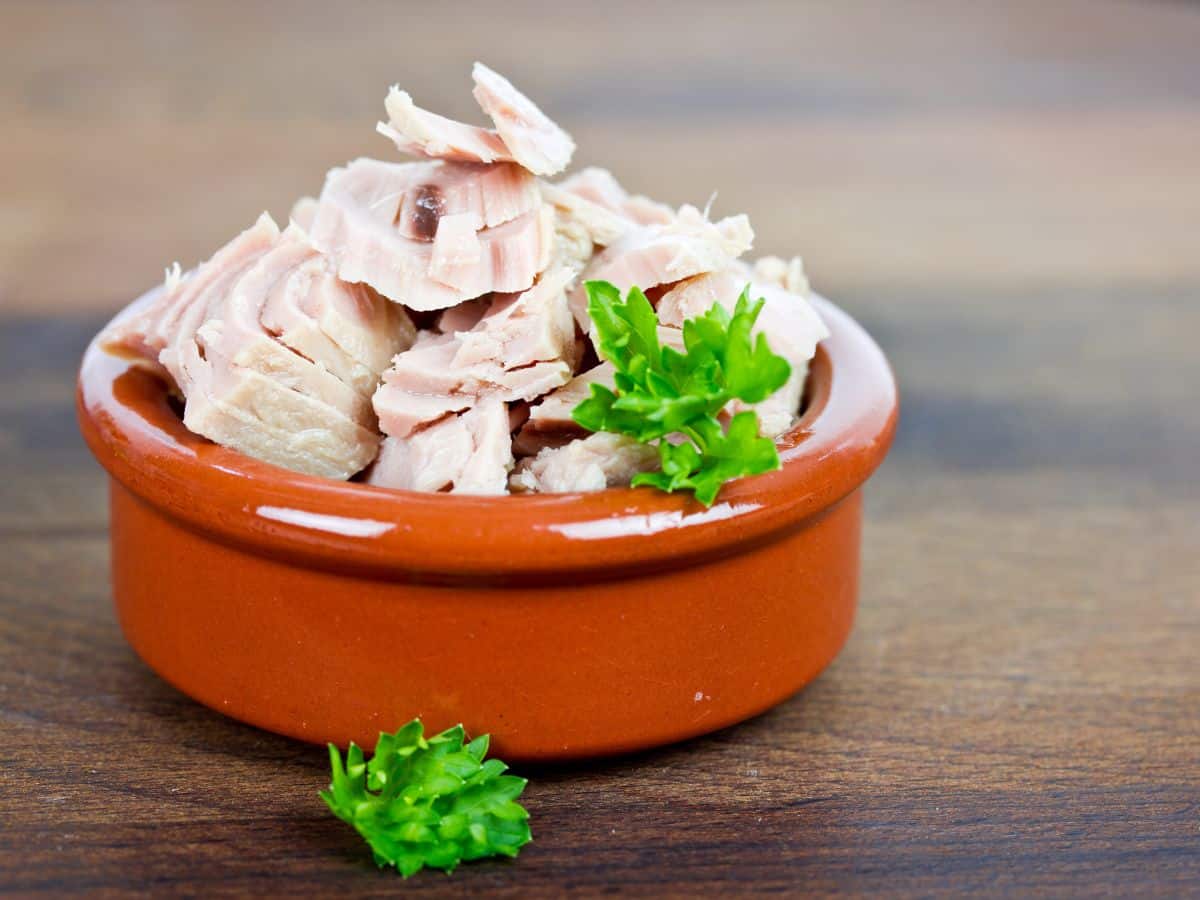
Tuna
Fresh tuna is one of the most high-protein fish in the ocean, packing nearly 31 grams of protein per cup. Enjoy a seared tuna steak as an entree or sliced atop a green salad. It’s also delicious in sushi rolls or as sashimi.
More affordable than fresh tuna, the canned variety is a convenient option that can stock an alpha gal’s pantry. Spread tuna avocado salad between two slices of sprouted grain bread, add a scoop to a bed of salad greens, or bake a can of tuna into a casserole. Or make this easy Nicoise salad, topped with canned tuna.
Sage Advice: Because tuna tends to have high mercury levels, the US Food & Drug Administration recommends limiting your weekly consumption to 12 ounces.
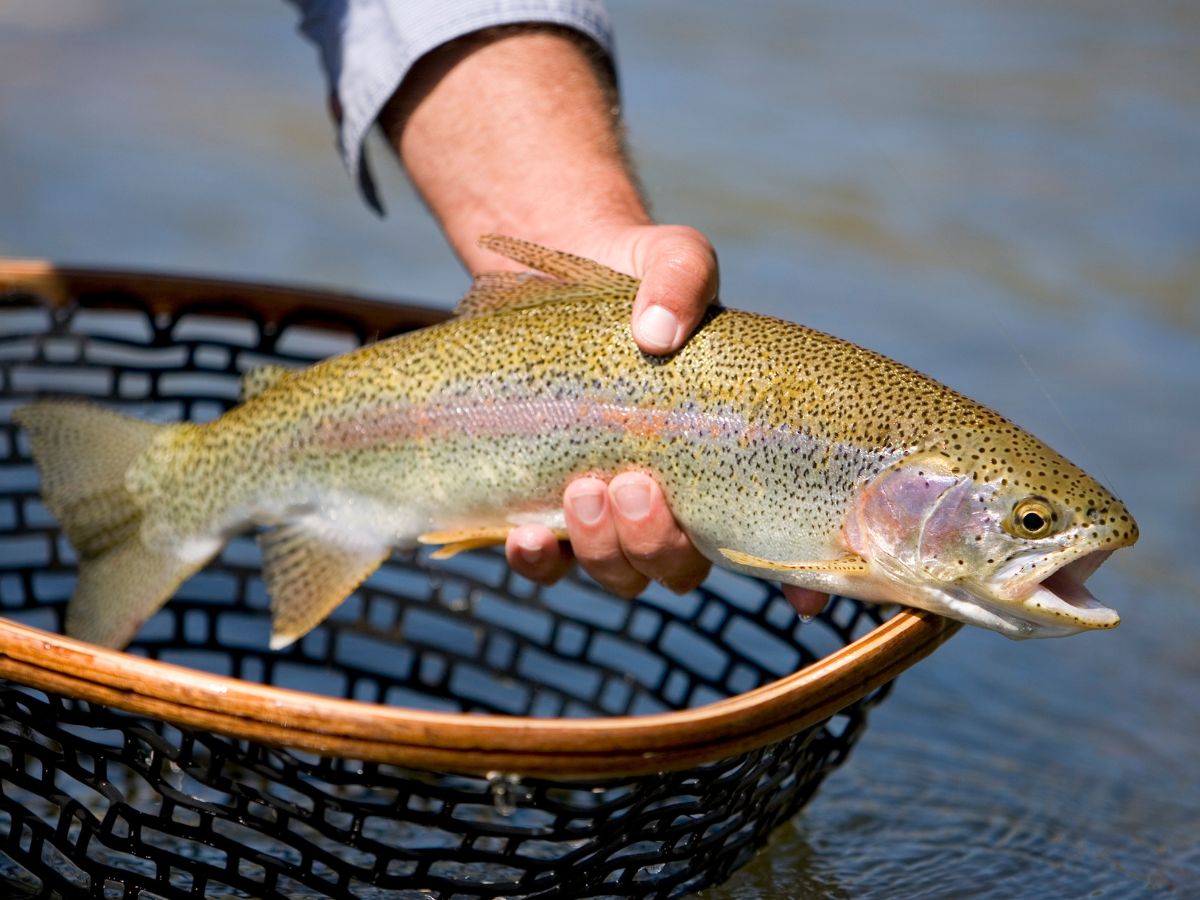
Trout
Found in rivers and ponds throughout North America, trout is high in protein, B vitamins, and omega-3 fats. And, because it’s low in mercury (unlike tuna), you can safely eat as much trout as you like each week. Trout is delicious baked, fried, and smoked. Cook it effortlessly in an air fryer, or serve smoked trout as an appetizer topped with creamy horseradish sauce.
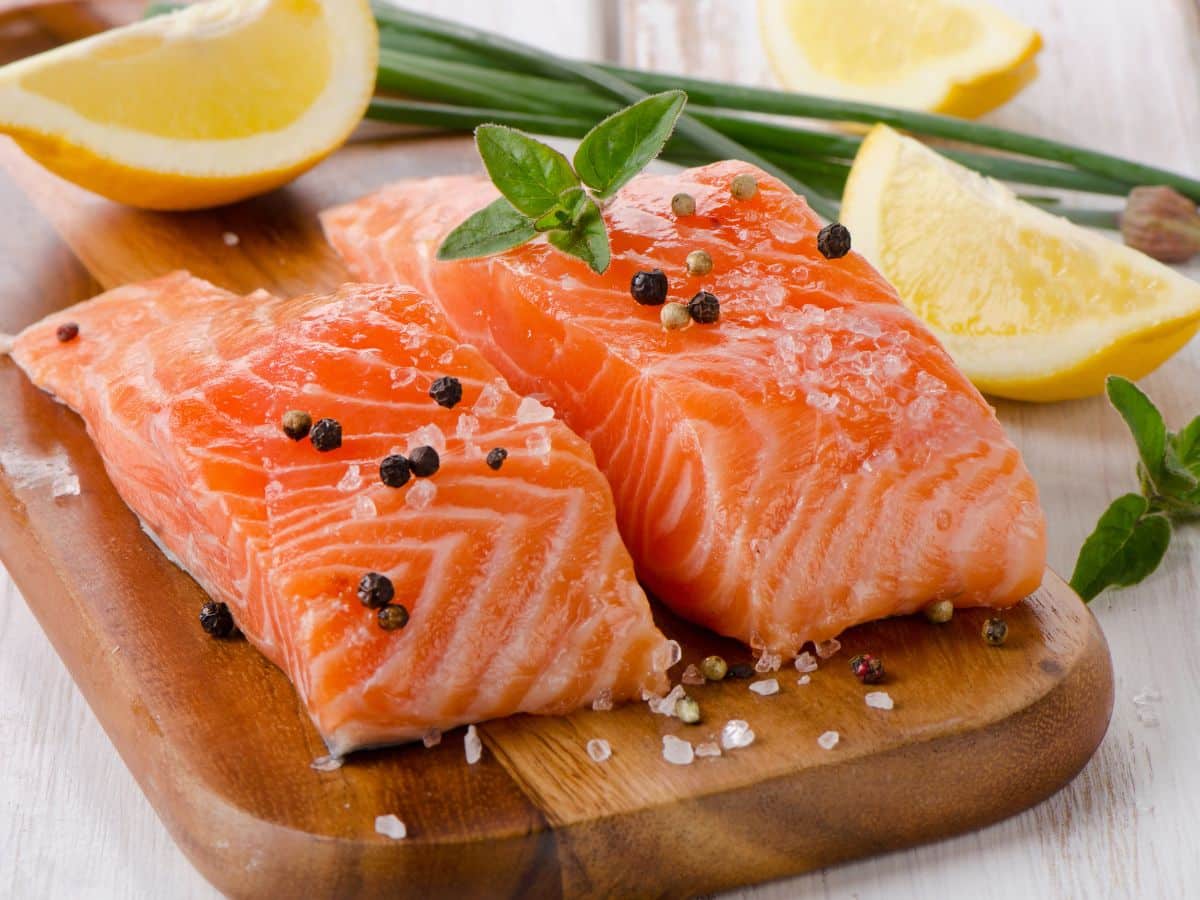
Salmon
Although not as affordable as tuna or trout, salmon is one of my favorite fish. Rich in omega-3 fatty acids, high in B vitamins, and believed to reduce the risk of heart disease, a 3.5-ounce serving of salmon contains more protein than three eggs. Grill a salmon filet as a main dish, or top grain bowls with this delicious protein.
Layer salmon lox on a bagel to add this animal protein to your breakfast, roast a salmon filet on a cedar plank with garlic and lime, or bake it in parchment paper. Or whip up this salmon salad, using canned salmon as an alternative to tuna salad (just use a dairy-free yogurt or mayonnaise in lieu of the plain yogurt if you cannot tolerate milk products). And for ideas of what to serve with this favorite fish, check out these sides for smoked salmon.
Sage Advice: Whether you use salmon, halibut, or cod, try this beer batter recipe to for perfectly tender fish inside a crispy flaky crust. Just be sure you use an alpha-gal friendly IPA.

Lobster
Compared with chicken, one cup of cooked lobster contians less saturated fat and fewer calories. However, lobster can be pricey and emotionally upsetting to prepare at home. Whole lobster is best steamed or baked, and here’s how to broil lobster tails perfectly at home (just be sure to use vegan butter if you’re an alpha gal who cannot tolerate dairy). Or use chunks of lobster to make a lobster roll or try this tempura fried lobster tail recipe for a fun twist.
What are Your Favorite Alpha-Gal Friendly Animal Proteins?
What are some of your favorite alpha-gal friendly animal proteins? Do you tend to eat more poultry or fish? Any additional tips or tricks to pass along? Share your experiences in the comments section below.

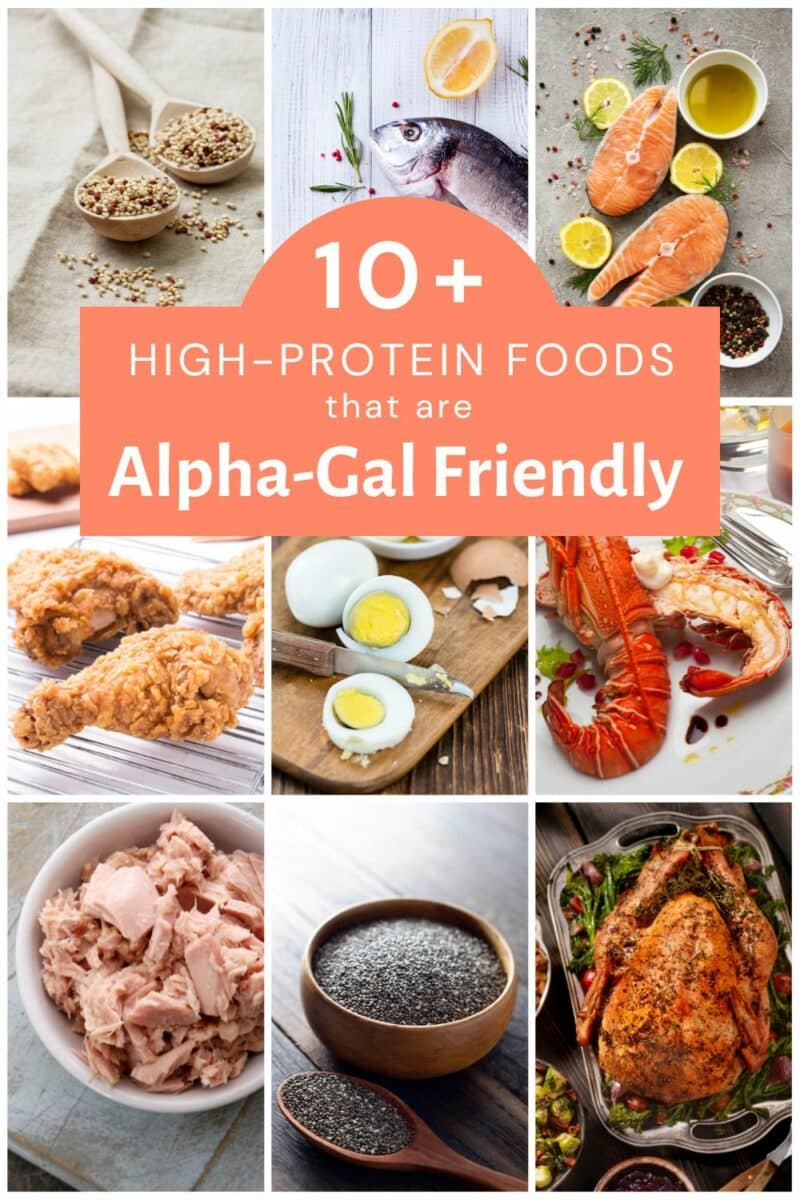

Thank you for sharing!

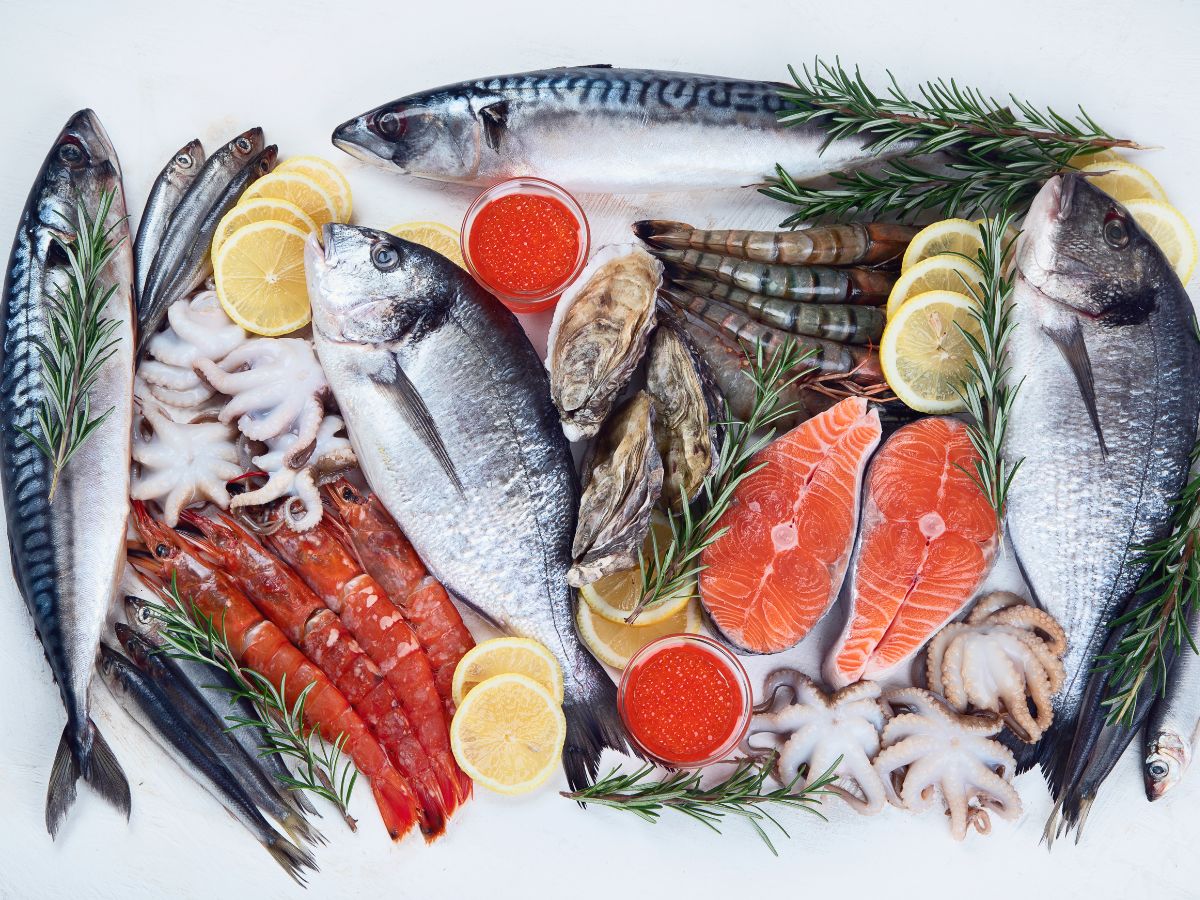
What an informative post, thanks for sharing so many ideas!
This is a great list. So glad to hear that this allergy doesn’t include all animal-based proteins. The info you provide on your blog is invaluable.
My dad swears by quail but I’ve never tried it, now I kinda want to. Love all these awesome protein options!
I was diagnosed 2 months ago. I have been on a real struggle bus trying to find out what I can and cannot eat. I find your site very helpful. It is overwhelming right now.
I am so sorry to hear you have alpha-gal! Do you feel you have a good grasp of your sensitivities? If not, that’s a really good place to start.
If you haven’t read it yet, these are the lessons I learned the hard way that I wish someone had shared with me when I was first diagnosed:
https://sagealphagal.com/living-with-alpha-gal-syndrome/
And when I couldn’t find a good trigger tracker to capture all of the info my PCP wanted me to document, I designed this one:
https://sagealphagal.com/food-allergy-trigger-tracker/
Good luck, and stay in touch. I’d love to hear how you’re doing as you get your arms around it all. Hang in there! <3
Hi Sage, thanks for your blog. I found out I had Alpha gal in 2022. But my lab test showed Alpha gal since 2017. I thought it was an enzyme in my digestive enzymes. My doctor finally explained the allergy last year. He doesn’t believe it’s from a tick.
It’s taken me several months to wrap my heart around. I live in central Arkansas but I was born and raised in Texas and was raised on beef and pork. I’m also GF and DF with several food allergies. Also, chemical sensitivities. I’ve given myself immunotherapy for environmental allergies.
I’m enjoying Emu and ostrich burger. Make my own crackers, muffins, pancakes and cookies. You have to get creative with all these allergies! Good luck to you and all the Alpha gals!
Hi Jenny! I’m so sorry that you have so many food allergies and sensitivities, but I’m inspired by how you are navigating around those gastronomical speed bumps and thriving. And, you’ll have to tell me how you make your own crackers! Thanks for leaving your comment, and I hope you find the tips and recipes here helpful — even as a “seasoned” alpha gal. <3
Have you ever heard of anyone not being able to digest meat at all after Alpha Gal?
Tell me more about what you mean when you say someone is not able to digest meat.